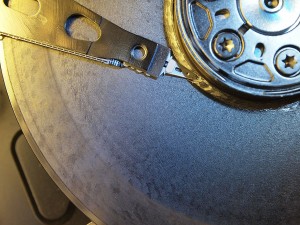
A hard disk drive with damaged platters, caused by a head crash. The data on this drive is not recoverable.
Whether we like it or not, those of us who rely on electronics to get our work done are guaranteed one thing: a data loss event. This means that at least once in our lifetimes (and sometimes more than that), every one of us who uses a computer, laptop, tablet, smartphone or similar device is going to one day stare at our screens and realize that the piece of information we expected to be there, just isn’t.
It can happen any number of ways. Sometimes, we users make a mistake and accidentally erase something we shouldn’t have… or someone else might’ve accidentally deleted something of ours that they shouldn’t have. Other times, it’s the computer’s fault: buggy software might’ve claimed to save something but didn’t, or a 10-year-old hard drive finally decided to give up the ghost. And sometimes, acts of nature (power outage, natural disaster, or other events beyond our control) will intervene and cause vital work to be lost.
Of course, we’ve all heard it time and time again: to protect your documents, photos, drawings, artwork, and other important data, you need to have backups. Unfortunately, while we all have heard this before and know it to be true, we don’t always follow through. In the past it’s been tedious to do regular backups; a chore we all dread. And so, it always falls but he wayside, and often, we get back into a backup regimen only after something bad has happened, and it’s already too late.
But take heart. A lot has changed recently. There ARE personal backup solutions out there that are surprisingly easy… and even automatic! keeping your stuff safe doesn’t have to be a tedious chore anymore… as long as you’re willing to invest a little time and effort at the beginning, and in some cases a small amount of cash on an ongoing basis.
Read the rest of this entry »
